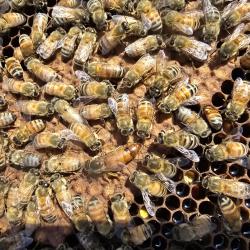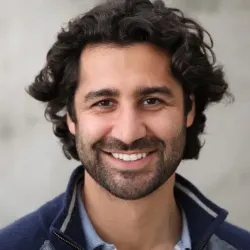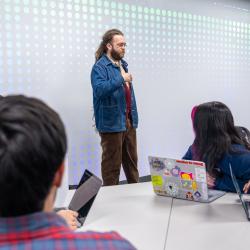Learning by Doing
Students in Break Through Tech's micro-internship program found confidence through mentorship from a former Sprintern.

When Helena Tesfaye started her micro-internship at event management software startup Goodshuffle, she found a friendly and familiar face in Abril Arias (B.S. ‘24, computer science).
Tesfaye, a sophomore computer science major, spent three weeks interning with Goodshuffle over winter break as part of Break Through Tech’s Sprinternship program, which launched in 2022 at UMD to propel more women and nonbinary students into tech careers. First- and second-year computing students are matched with host organizations in the D.C. area to spend three weeks immersed in their workplace cultures while tackling assigned business challenges.
Mentoring the Next Generation

When Tesfaye and her fellow Sprinterns started, they met Arias, who worked with Goodshuffle for UMD’s first cohort of Sprinterns in 2022. During that time, Arias and her former Sprintern team—senior computer science major Mary Redpath, Veda Singireddy (B.S. ‘24, computer science) and Joyce Tijani (B.S. ‘22, computer science)—built a front-end app for warehouse fulfillment workers to manage inventory. Three years later, Arias mentored a new generation of Sprinterns as a full-time software engineer at Goodshuffle.
“Abril was like our big sister,” Tesfaye said. “We would always go to her first if we ran into an error or if there was something we didn’t know. She also talked with us about her time at UMD, her other internships and how she came to Goodshuffle full-time.”
From the beginning of their Sprinternship, Arias encouraged the Sprinterns to speak up, ask questions and get to know software engineers during group meetings they called ‘coffee chats.’
“I pushed them to ask questions of the team because that’s something I struggled with when I was a Sprintern,” Arias said. “I was so proud to see how each of them grew in confidence in just three weeks.”
As the Sprinterns met more Goodshuffle employees, they “unlocked” new resources and guidance for their project.
“After we went to a coffee chat with one of the engineers, we would joke that we’d unlocked them as a character,” Tesfaye said, “because the next time we ran into an error, we would go to them instead of bothering Abril again. Eventually, we made it around to the whole product team with our questions.”
Creating Artificial Intelligence Features
The students split into two teams to apply what they learned, creating parallel features and making the Goodshuffle platform’s onboarding process easier for vendors and clients. Tesfaye and junior computer science major Audrey Nguezet Gouanet used artificial intelligence to create a feature that autogenerates personalized terms and conditions documents for vendors based on a series of inputs. Freshman Letters and Sciences student Han Lin and senior computer science and immersive media design double major Christina Kwon worked with Textract on a feature that allows users to upload existing documents and autogenerate terms and conditions documents.

“For example, if I'm a balloon rental company, and I want these terms, policies, etc. to be considered, our project would answer those questions and then make a call to the API from Open AI. That then generates terms and conditions for the client,” Tesfaye explained.
Once they finished the automated terms and conditions feature, Tesfaye and Nguezet Gouanet worked on a streamlined messaging tool and an "Unshuffled" feature that gives vendors a summary of their project updates. At the end of three weeks, the four students presented their features to the Goodshuffle team.
“The leadership team encouraged us to focus on how we present ourselves and how to stand out,” Tesfaye said. “Having clarity of voice, not saying ‘like’ or ‘um’ every five seconds, and projecting can really make a difference. We got to put that advice to work in our final presentation.”
Now that the Sprinterns have started their spring semester, Arias is carrying their projects forward—which she calls a true “full-circle moment.”
“It was a very full-circle moment. I was excited for Goodshuffle to host Sprinterns again because I got to share that intern to full-time employee experience with them, which I would've found so helpful a few years ago,” Arias said. “I’m happy to move their work forward over the next few months and implement these features that they worked so hard to create.”







